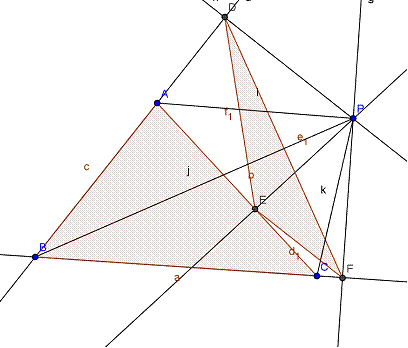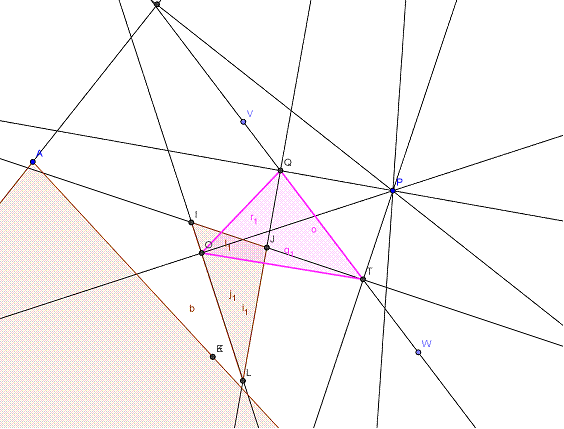Problema 646
A) Let G1 be the triangle formed by the feet of the perpendiculars from P on the sides of the triangle G. Form G 2 from G1 and P in the same way. Likewise construct G 3 from G2 and P. Then the triangle G3 so constructed is necessarily similar to the original triangle G.
Sea G1 el triángulo que forman los pies de las perpendiculares trazadas desde P a los lados del triángulo G.
Construimos G 2 a partir de G1 y P de la misma manera. Igual G 3 a partir de G2 y P.
Entonces el triángulo G3 es necesariamente semejante al triángulo original G.
El punto P es del plano y no está sobre los lados de G.
OPPENHEIM, A. (1961): THE ERDOS INEQUALITY AND OTHER INEQUALITIES FOR A TRIANGLE. The American Mathematical Monthly, Vol. 68, No. 3 (Mar., 1961), pp. 226-230.
Solución del apartado A) del director:
Supongamos P interior a ABC

Sea ‹PBA= α, ‹PBC= β, ‹PCB= γ, ‹PCA= θ, <PAC=Λ, ‹PAB= ω.
ES: ‹PEG= β, ‹PGE= α, ‹PGF= θ, ‹PFG= γ, <PFE=ω, ‹PEF= Λ.
Por ser PGBE, PGCF y PFAE cuadriláteros concíclicos.

Sea G2 HDI . Por razones similares tenemos:
‹PEG= β, ‹PGE= α, ‹PGF= θ, ‹PFG= γ, <PFE=ω, ‹PEF= Λ.
ES: ‹PIH= θ, ‹PHI= α, ‹PID= Λ, ‹PDI= β, <PHD=ω, ‹PDH=γ.

ES: ‹PIH= θ, ‹PHI= α, ‹PID= Λ, ‹PDI= β, <PHD=ω, ‹PDH=γ.
Por último de manera análoga, en G3, tenemos:
ES: ‹PKJ= β, ‹PJK= γ, ‹PLJ= Λ, ‹PJL= θ, <PLK=ω, ‹PKL=α.
Luego : ‹JKL= α+β=<ABC, ‹LJK= γ+θ=ACB , ‹KLJ= ω +Λ=<BAC.
Así pues, son semejantes, cqd
Caso de ser P exterior por ejemplo en la amplitud de B, y el semiplano que no lo contiene a B.

Tracemos PA, PB y PC y G1, DEF, triángulo pedal de ABC respecto a P

Sean: ‹PBA= α, ‹PBC= β, ‹PAD= γ, ‹PAC= θ, <PCA=Λ, ‹PCF= ω.
Es por ser concíclicos los respectivos cuadriláteros:
‹PFD= α, ‹PDF= β, ‹PEF= ω, ‹PED=γ,
<PFE=Λ, (por lo que <DFE=Λ-α), ‹PDF= θ (por lo que <EDF=θ-β).

Así considerando las prolongaciones de EF , EFG y de ED, EDH, tenemos que :
‹PFD= α, ‹PDF= β, ‹PEF= ω, ‹PED=γ, <PFG=180-Λ, ‹PDH=180- θ .
Tracemos ahora G2, IJL, con I sobre DE, J sobre DF y L sobre EF

Tenemos: <PJI=180- θ al ser concíclico PJID. <PJL=180-Λ al ser PJLF concíclico.
<PLJ=α, y <PIJ=β.
Sean R y S sobre las prolongaciones de IL, en sentido RILS (que RS no aparecen en la figura).
<PIR=180-ω, <PLS=180-γ.
Ampliemos la figura para generar G3,

Tenemos que considerar OQT.
Análogamente a lo hecho anteriormente, es:
<POQ= <PLQ=<PLJ=α, <POT=<PIT=<PIJ=β
<PQT=<PJT=180-PJI=180-(180-θ)=θ. <PTQ=<PJQ=180-PJL=180-(180-ω)=ω.
Prolonguemos OTU y OQY:
Por analogía de las estructuras estudiadas, es
<PTU=180-<PFD= 180- (180-Λ)=Λ.

<PQY=180- <PLS=180-(180-γ)=γ.
Así, <QOT=α+β=<ABC.
<OQT=180-<YQT=180-<YQP-<TQP=180-γ-θ=<BAC.
<OTQ=180-<UTQ=180- <UTP-<PTQ=180- Λ- ω= <ACB.
Es decir, cqd, ABC y G3 son semejantes.